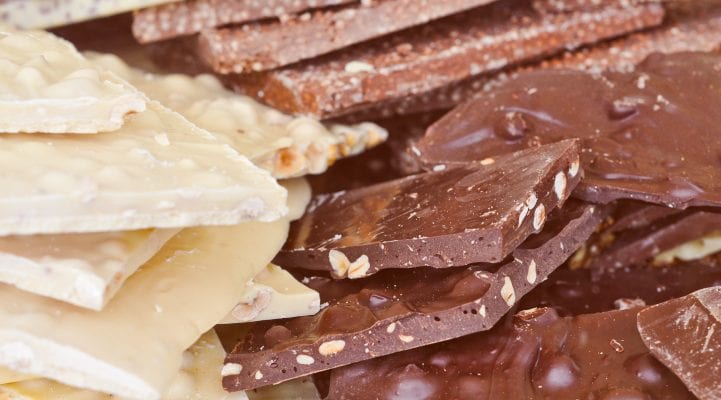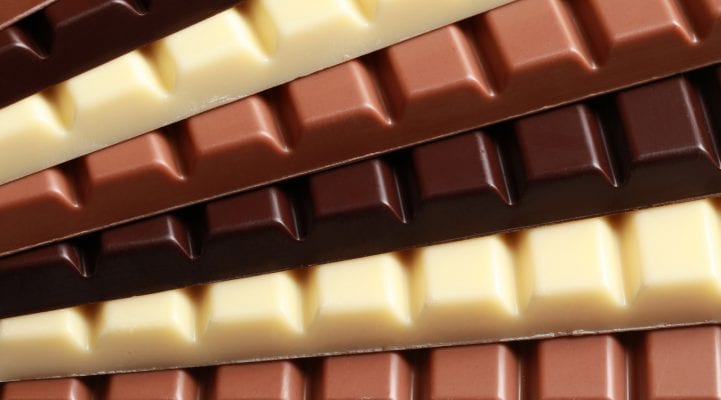Can you actually keep chocolate and pralines in a fridge without any problem? And if so, what should you bear in mind when doing so? Read on to find out everything you need to know to store your chocolate correctly.

Dearest chocolate lovers and praline devotees,
Today, we would like to get you thinking about how to safely store your lovely heavenly pleasures and most tender temptations, i.e. your sumptuous chocolate treats! OK, you might not get quite so emotional about your favourite snack and pick-me-up – maybe you’re more in tune with the German brand that promoted its chocolate with the slogan: “Square. Practical. Good.” – but this delicious treat, which comes in countless varieties, still deserves some looking after.
Most of us will be familiar with the following: it’s a warm summer’s day and you’ve left your chocolate out on a sunny windowsill or in the car and, when you notice it, it’s inevitably turned into something resembling sticky drinking chocolate! In a desperate attempt to revive your chocolate you hurriedly slam it in the fridge, only to discover later that your re-hardened chocolate doesn’t look too appetising any more. Apart from the expected change of shape, white marks have formed on its surface! Based on this experience, it’s easy to conclude that refrigerating chocolate actually harms it in some way. Surely chilling it must have a detrimental effect on its taste and shorten its shelf life? It can’t really be OK to keep chocolate in the fridge, let alone in a freezer, can it?
Chocolate science: influencing storage factors
Oxidation:

When chocolate comes into contact with air and light then a process known as oxidation occurs, and this means that the fat contained in the chocolate changes into other substances leading to marked impairment of the flavour and to an unappealing smell. The cocoa in chocolate contains natural substances that slow down this oxidation process. Dark chocolate, with a relatively high cocoa content, is better protected against the effects of oxidation than milk chocolate. White chocolate, which doesn’t contain cocoa constituents, doesn’t have this protection at all and is therefore particularly sensitive to exposure to air and light. In order to prevent oxidation, you need to store your chocolate in airtight, lightproof packaging.
Diffusion:
Substances from the surrounding environment can diffuse through the packaging into the chocolate, and water or alcohol can diffuse out of any chocolate filling into the environment. It is for this reason that chocolate is nowadays often packaged in sealed plastic, although many of us will be more familiar with chocolate that is wrapped in aluminium foil with an outer paper/cardboard wrap.
Ostwald Ripening:
Similar to what happens with ice crystals, small cocoa butter crystals become larger over time, due to an effect known as Ostwald ripening. These crystals can develop at the surface, becoming visible as a white deposit – a “fat bloom”. The process is promoted by temperature fluctuations and you might have noticed the results of this phenomenon if you have left chocolate out on a cold windowsill overnight. As it warms up again through the day, the chocolate begins to “sweat” and, in the process, cocoa butter is deposited on the surface, creating an unappetising white coating on the chocolate. However, rest assured, this coating has nothing to do with mould and does not harm the taste or you!
Hygroscopy:

Chocolate has a water content of about 0.6% and, without protective packaging, can quickly absorb moisture to promote, as has been described above, a “fat bloom” (or even mould in the worst case scenario). On the other hand, packaged chocolate is extremely safe from a microbial perspective because, due to its very low water content, spores are barely able to multiply on it. Odour and taste transmission:
Fat-soluble chemicals, such as those found in cheese, fish and meat aromas, are quickly absorbed by chocolate so that it can easily smell and taste “old”. White chocolate, in particular, quickly absorbs ambient smells and should be kept in airtight, fragrance-neutral packaging. Heat:
Cocoa butter comes in different crystal forms. The type III and type IV crystal forms are eliminated during manufacture, so that only the desirable type V crystal form remains in the chocolate we buy. Type V crystals have a melting point of around 32 °C, which means that chocolate, quite literally, melts in the mouth! At higher temperatures (for example: when chocolate is left inside a car in summer), larger type IV crystals form, which have a melting point of 37 °C. The consequence of this is that the chocolate no longer tastes so good and it no longer melts in the mouth. What does all this mean for the correct storage of chocolate?
Storage in a freezer:
Freezer storage tests at -18 °C showed that, at this temperature, the chocolate’s sensory properties were preserved very well. Therefore, if you wish to preserve seasonal treats that you can only obtain during the Christmas period, a freezer is the best choice. Storage in a refrigerator:
If chocolate remains in its packaging, it can be kept in a fridge at any temperature and humidity for months, without any problem in terms of impairment of its flavour and smell. Should the packaging be open, the chocolate needs to be stored in airtight conditions, as mentioned above,
in order for it not to absorb foreign odours. Comparative tests between storage at room temperature and storage at refrigerator temperature have shown that, after 3 months (at the earliest) in the case of sensitive chocolate truffles, and after 6 months (at the earliest) in the case of “normal” full milk chocolate, quality differences were evident. In the case of chocolates with a “critical content”, e.g. pralines with a cream filling, from a microbial point of view, storage in a refrigerator is most definitely recommended. In conclusion:
* Chocolate can be kept “fresh” for several years in a freezer.
* Storing chocolate in a refrigerator is better than at room temperature (about 20°C).
* When storing packaged chocolate in a fridge there are no particular temperature or humidity requirements.
However, in the author’s opinion, it is best not to store this most wondrous temptation, seduction and pleasure for too long, but rather to eat it, without delay, following purchase! Most chocolaty delicacies should simply be sampled as soon as feasibly possible!

Many fellow aficionados will find themselves agreeing heartily with the Irish author Oscar Wilde, who said: “I can resist everything, apart from temptation.”
If you enjoyed this post, why not subscribe to our Newsletter? If you have any questions about this post, then please write to us. Use the comment function below this post or start/join in discussions with us on Facebook.